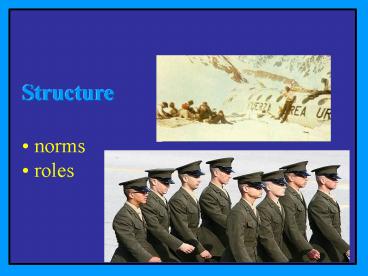Group Structure - PowerPoint PPT Presentation
1 / 29
Title:
Group Structure
Description:
once they develop, resistant to change and passed from current members to new members ... Proscriptive. set the standards for expected behaviors. Prescriptive ... – PowerPoint PPT presentation
Number of Views:78
Avg rating:3.0/5.0
Title: Group Structure
1
- Structure
- norms
- roles
2
- Structure
- norms
- roles
- intermember
- relations
Emergent (self-organizing) and/or deliberately
designed
3
What Are Norms?
- Norms Consensual and often implicit standards
that describe what behaviors should and should
not be performed in a given context.
4
(No Transcript)
5
Development of Norms
- Sherifs studies of the development of norms in
groups - Convergence in actions, thoughts, and emotions
occurs over time
6
Sherif's (1936) autokinetic effect studies
Judged distance a dot of light moved in a
darkened room
7
Autokinetic effect the stationary dot of light
will seem to move
8
What if people make their judgments with others,
and state estimates aloud?
9
Average distance estimates
Alone
Group Session 1
Group Session 3
Group Session 2
Conformity! Initially, they differ but over
trials, they converge
10
Do Norms Sometimes Take on a life of their own?
11
X
Confederate
Average distance estimates
Person B
Person C
Alone
Group Session 1
Group Session 3
Group Session 2
Sherif put in a confederate in some groups who
made exaggerated distance judgments others
conformed
12
Person B
Person C
Average distance estimates
Person D
Group Session 4
Group Session 1
Group Session 3
Group Session 2
Even when the confederate was replaced, the norm
remained
New member
13
Person C
Person D
Average distance estimates
Person F
Group Session 4
Group Session 1
Group Session 3
Group Session 2
The exaggerated norm lasted for many
generations of replacements
14
- Sherifs studies of the development of norms in
groups - - Members often internalize these consensual
standards - - Result norms are self-generating and stable
- Examples
- Eating disorders in groups (binging, purging,
excessive exercise) - Alcohol use on college campuses (Perkins and
social norm interventions)
15
What Are Roles?
- Roles The types of behaviors expected of
individuals who occupy particular positions
within the group (e.g., roles in a play) - Independent of individuals
- Flexible, to an extent
- Structure interaction, create patterns of action
16
What Are Roles?
- Role differentiation The emergence and
patterning of role-related actions - Task roles pertain to the work of the group
- Relationship roles pertain to relations among
members. - Roles tend to become specialized over time
- Task and relationship role demands tend to be
incompatible with one another
17
What Are Roles?
- Moreland and Levine's group socialization theory
- Types of members prospective, new, full,
marginal, and former (ex-member) - Phases investigation, socialization,
maintenance, resocialization, and remembrance - Processes recruitment/reconnaissance,
accommodation/assimilation, role negotiation,
tradition/reminiscence - Transition points entry, acceptance, divergence,
exit
18
(No Transcript)
19
What Are Roles?
- Role stress
- Role ambiguity
- Role conflict (interrole conflict and intrarole
conflict) - Role fit
20
What Are Status Networks?
- Status network Stable pattern of variations in
authority and power
21
What Are Status Networks?
- Status differentiation
- Competition for status (pecking orders)
- Perceptions of status
- Expectation-states theory diffuse and specific
status characteristics
22
What Are Status Networks?
- Status generalization when irrelevant
characteristics influence status allocation - Minorities, solos denied status
- Online groups and the status equalization effect
23
What Are Attraction Networks?
- Attraction network (sociometric structure)
Stable patterns of liking-disliking
24
What Are Attraction Networks?
- Sociometric differentiation
- Types of group members stars, rejected,
neglected - Features reciprocity, transitivity, homophily
(clusters) - Heider's balance theory likes and dislikes are
balanced
A
A
A
-
-
B
C
B
C
B
C
-
25
What Are Attraction Networks?
- What factors predict sociometric standing?
- Having socially attractive qualities (e.g.,
cooperativeness or physical appeal) - Person-group fit
26
What Are Communication Networks?
- Communication network formal and informal paths
that define who speaks to whom most frequently
27
What Are Communication Networks?
- Types wheel, comcon, chain, circle
- Centralized vs. uncentralized
28
(No Transcript)
29
What Are Communication Networks?
- Network and location in the network influences
many processes - Information saturation centralized networks are
most efficient unless information overload - Individuals who occupy more central positions are
more influential (and more satisfied) than those
located at the periphery. - Hierarchical networks and information flow More
information flows downward and unrealistically
positive information flows upward































